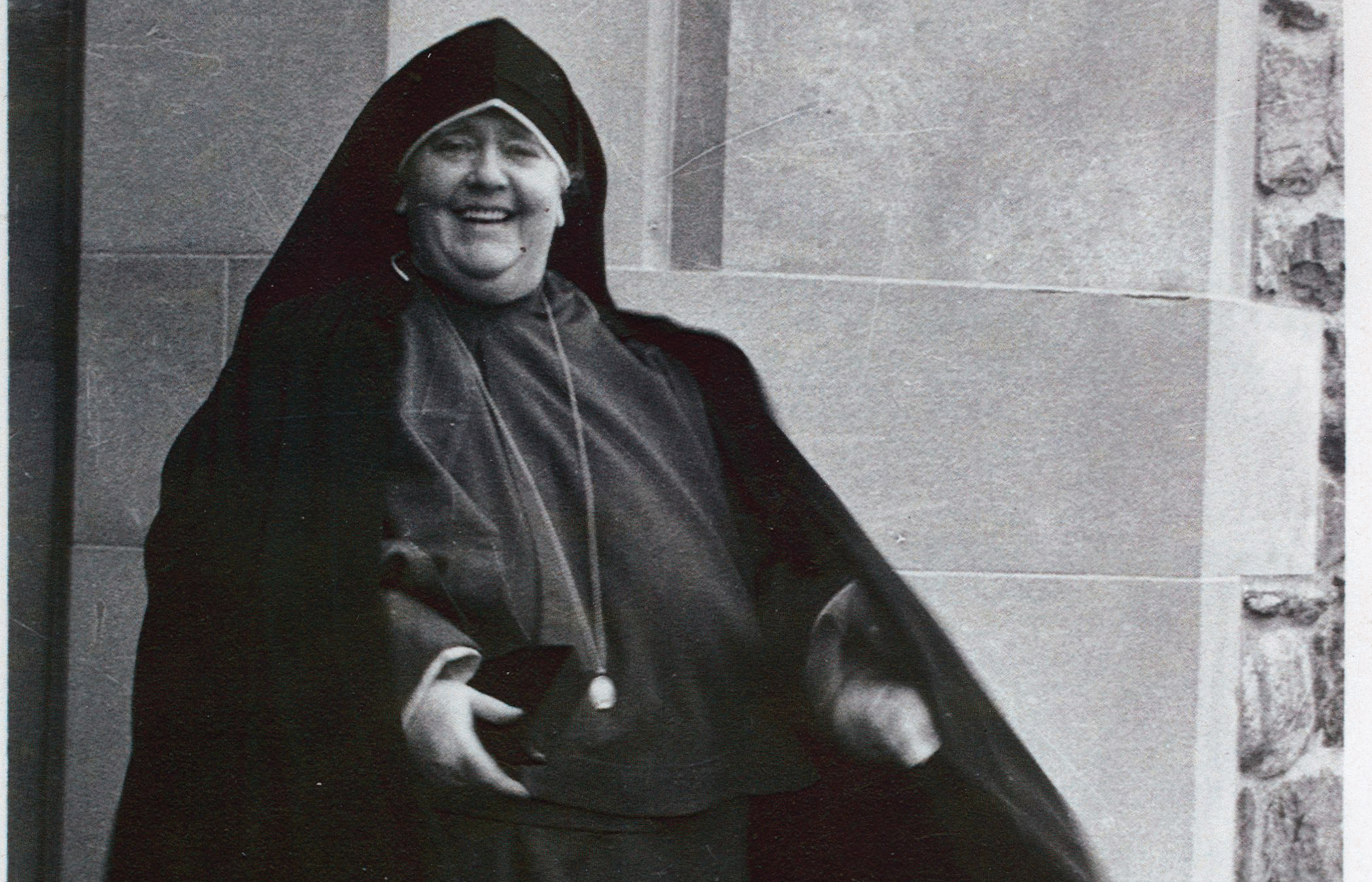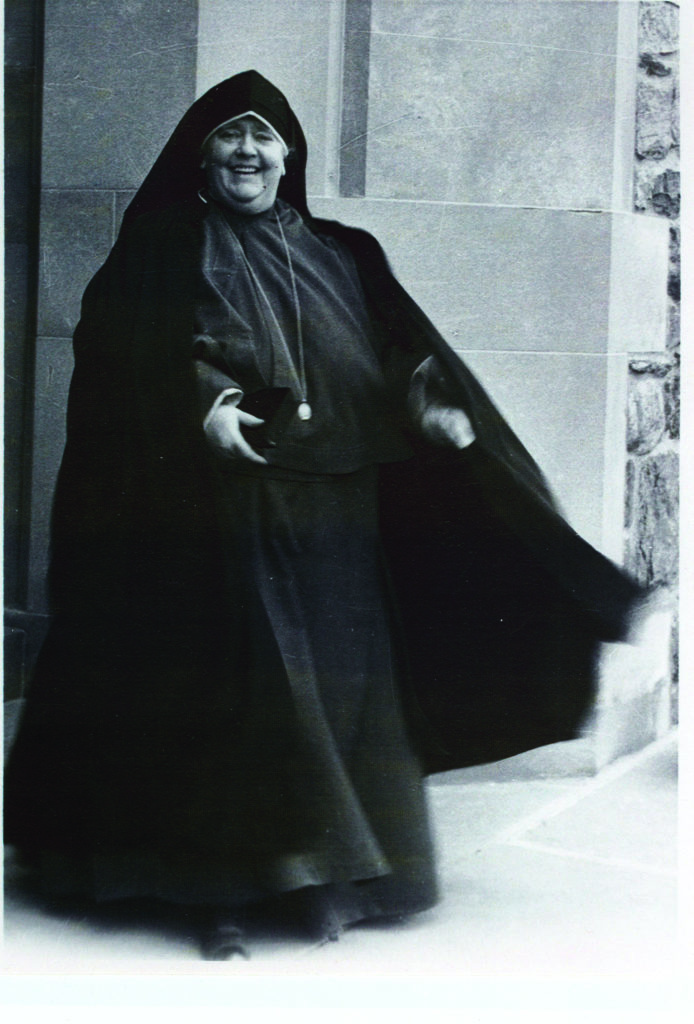
Mother Mary Joseph, founder of the Maryknoll Sisters.
The history of Christianity is marked by the stories of countless holy women who struggled to assert their full humanity and to follow where God was calling them, even when this challenged the prevailing options of their time—even when this truly meant “going against the current paying personally.” The same may be said of many male saints. But in the case of women saints, this often meant something extra and more specific: challenging the assigned gender codes of their culture—in some cases codes invested with divine authority—in order to assert their own spiritual integrity.
For some, this meant claiming the freedom to remain unmarried; for others, to escape the restrictive enclosure of a convent, to engage in active apostolic work among the poor, or to travel across the world to proclaim the gospel. Some claimed the authority to write their own community rules, to interpret scripture in new ways, or simply to describe their own experience of God. Others found in Christ a mandate to oppose slavery, war, and social injustice. Later, in light of their achievements and the space they created for new models of discipleship, such women were sometimes honored as “faithful daughters of the church.” But while they lived they often endured extraordinary opposition or even persecution. In the struggle to pursue their vocations—especially if this involved any form of innovation—holy women have typically contended with male authorities who were only too eager to inform them that their visions or desires contradicted the will of God.
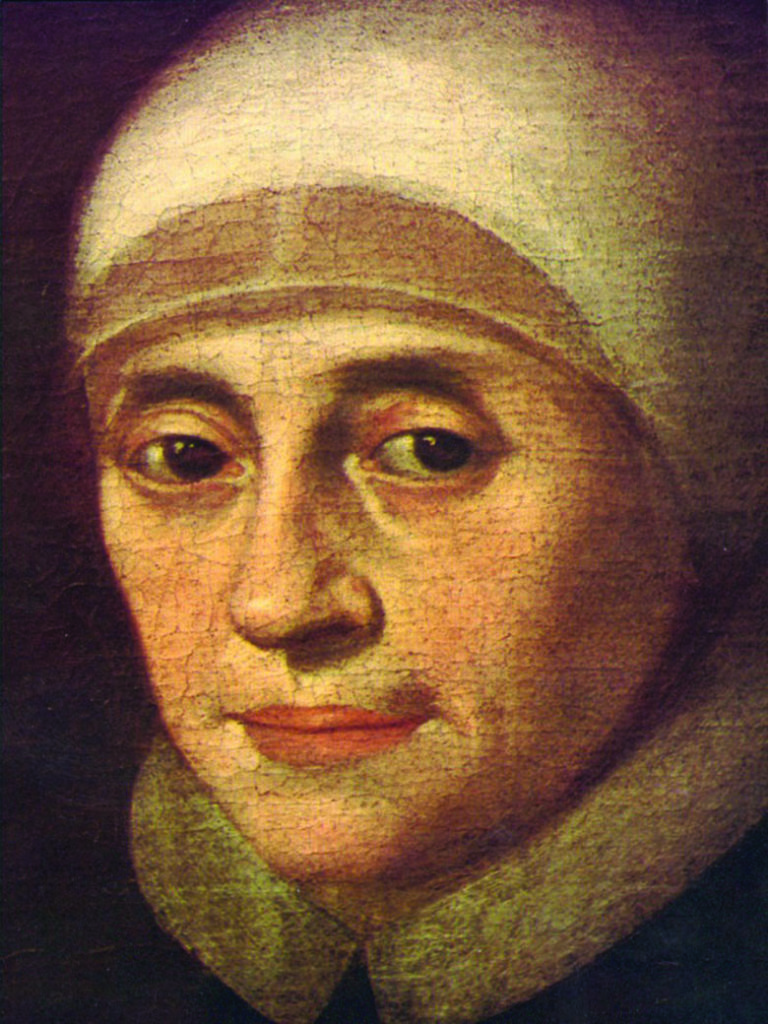
Consider the story of Mary Ward, founder of the Institute of the Blessed Virgin Mary, who died in 1645. [1] Her life was set against the background of Elizabethan England and intense persecution of the Catholic religion. Her family was among the landed gentry whose wealth and title allowed some private space to resist the severe anti-Catholic decrees. Her childhood was marked by secret visits from priests—often Jesuits—who had been quickly ordained overseas, smuggled into the country, and secretly passed from house to house to celebrate their forbidden Masses. This illicit practice of the Catholic religion was an act of treason, which could mean death not only for the priest but also for the sheltering family. In this context, Mary insisted that she was called to be a nun—a somewhat fantastic notion, given that at the time there was not a single remaining convent in England. Nevertheless, with the grudging respect of her confessor, she won her family’s approval and so was smuggled out of the country to Catholic Belgium
Unfortunately, Mary had difficulty finding the vocation she was seeking. She had come to believe that she was not called to conventional enclosed religious life. Instead, inspired by the example of the Jesuits, she conceived of an institute of women living in a non-enclosed community, free of episcopal authority, who could carry out apostolic work in the world. To say the least, it was an idea ahead of its times.
Nevertheless, Mary was able to convince a number of influential church authorities, including a good Jesuit confessor, of the value of her plan. There followed the first of a number of clandestine visits to England to seek recruits for her community. Disguised as a traveling gentlewoman, she made the rounds of Catholic households, exhorting the faithful, helping to prepare people for baptism, visiting and comforting imprisoned priests, and inspiring a half dozen women to take the leap with her into the unknown.
During one of these visits she was finally discovered and imprisoned. Sentenced to death, she was instead permitted to accept exile. Back on the Continent, Mary went about forming her band of followers into a religious community while simultaneously pursuing official approval for her Institute. In Rome, she won an audience with the pope, who tentatively permitted her to develop her project. But formal recognition was not forthcoming.
Her enemies, as she discovered, were not only in Protestant England. Her devotion to the spiritual vision of St. Ignatius fed the distrust of secular clergy, who were rivals of the glamorous Society of Jesus. Her Institute was mocked as a house of “Lady Jesuits.” But beyond the territorial jealousies of English Catholics, there was the wider resistance, in principle, to her radical vision. Her adamant insistence that the Institute be non-enclosed and remain free of episcopal governance ran head-on against the prescribed place of women in the church. While some bishops offered polite approval for her plans, especially her schools for girls, most ultimately shared the opinion of one priest who noted, “When all is said and one they are but women!”
After she had established a number of houses and won wide admiration for her exemplary schools, notification came from Rome in January 1631 that the Institute was to be suppressed. Within days, messengers arrived to take Mary into custody on the charge of being a “heretic, schismatic, and rebel to the Holy Church.” Though her imprisonment in a convent was brief, the suppression of the Institute continued in effect, and she remained under a cloud of ecclesial disapprobation. In broken health she returned to England, where the penal laws against Catholics were still in effect, and where once again she faced surveillance and the possibility of arrest. She died in York at the age of sixty. Official recognition of her Institute would come only fifty-eight years after her death.
The last two centuries have been marked by dramatic and accelerating change in the role and status of women in the church and society. The struggle by women to assert their equality and to challenge patriarchal structures and values has been one of the true signs of the times. In this struggle, it is probably safe to say that more dramatic changes in consciousness and social custom have occurred in the past fifty years than in many preceding centuries.
Catholic women have not always served in the forefront of these movements for change. Nevertheless, the history of female holiness, from the anonymous disciples of the New Testament up to the present, could be told as a story of women who discovered, through their relationship with Christ, the power to name themselves, to express their identity, and to value their own experience in ways that often set them apart from the roles defined by the church or the wider culture of their time.
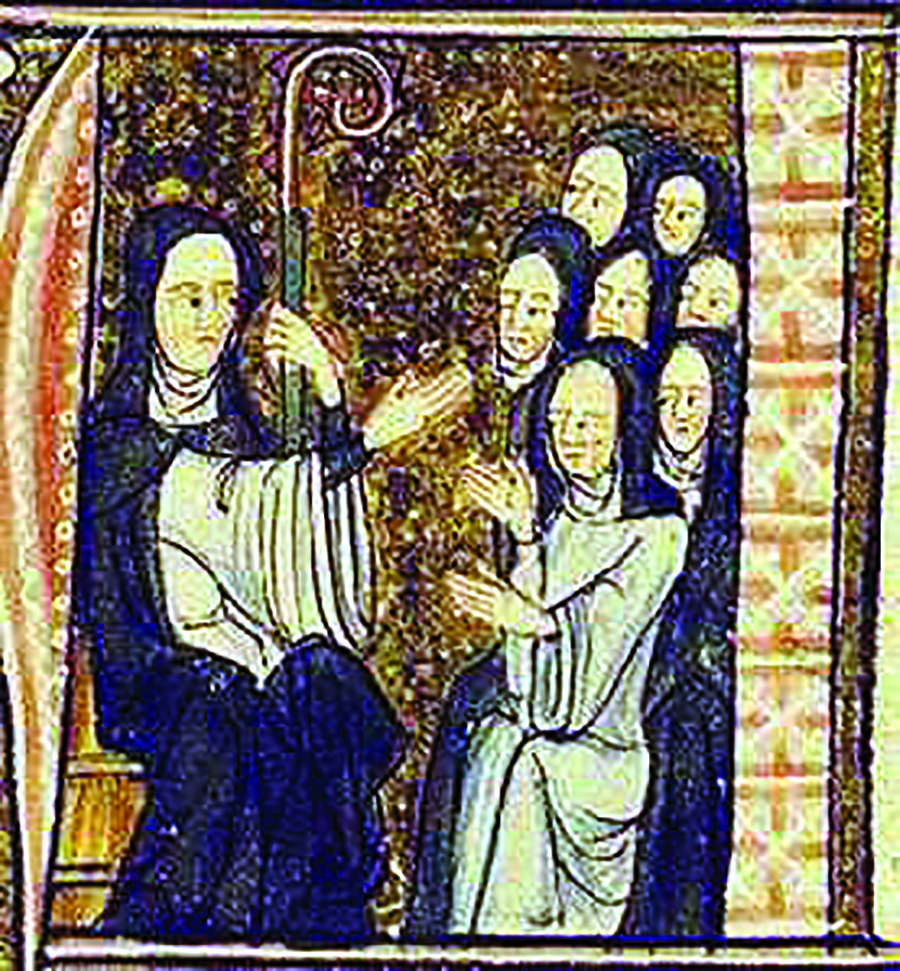
Many of the great women saints of history are certainly in this category. There is St. Hildegard of Bingen, an eleventh-century abbess and mystic, who was clearly one of the remarkable figures of her age: founder of a Benedictine religious community; author and theologian; prophet and preacher; musician and composer of works that are still performed; poet and artist; doctor and pharmacist who anticipated the principles of homeopathy. [2] Yet for eight hundred years she remained in relative obscurity. Only in recent decades has she emerged into the light, partly thanks to contemporary interest in the idea of women in history—yet also in belated recognition of an ecologically minded and holistic spirituality that speaks prophetically to our own time.
Hildegard had a wide understanding of the cosmos as a whole and of the human place in it. Human beings, she wrote, are the universe in microcosm—made of the same elements that constitute the world. But within the great cosmos human beings are the thinking heart, called to be co-creators with God in shaping the world. Through human sin the world feel out of harmony with the Creator. But this did not erase the original goodness and blessing of creation. Through Christ—first fruits of a new creation—the cosmos and human beings find their way back to their original destiny. Constantly Hildegard refers to God as “Living Light,” and employs a remarkable word—“greenness”—to describe the animating energy or grace of God that shines forth in all living things. For this wide-ranging and holistic vision she was recently named by Pope Benedict XVI as a Doctor of the Church. And yet this proclamation fails to acknowledge or reflect the irony that until that point Hildegard had not been officially canonized; that in fact she was excommunicated in the last years of her life, her convent placed under interdict, and her teachings essentially ignored for many centuries.
Lest we suppose that such ordeals are a relic of the dark ages, I was struck in reflecting on women saints in the nineteenth century by how often their lives were marked—almost as a rite of passage—by actual periods of excommunication. This is seldom emphasized in their official vitae, which again tend to emphasize traditional virtues of piety, submission, and obedience.
Consider, for example, one of the recently canonized saints of the Americas, Mother Theodore Guerin (1798-1856), founder of the Sisters of Providence of St. Mary of the Woods. [3]
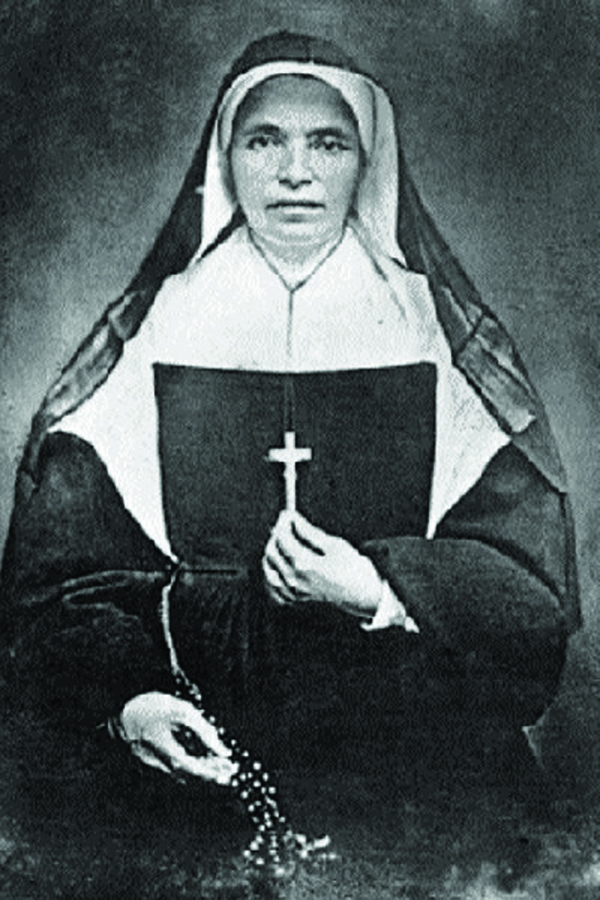
She is remembered for her work in bringing a community of sisters from France to a new mission in the frontier territory of Indiana. Beginning with their foundation in a log cabin in the middle of the forest, the sisters contended with fierce winters, fires, locusts, droughts, and floods, while they steadily developed their ministry among the pioneer settlers of the region. And yet, again, the most difficult ordeal of their early years involved relations with their local bishop. Mother Theodore initially described him as “an excellent father.” Never, she said, had she found “a heart more compassionate under an exterior so cold.” But before long she was describing his temperament as “one of those which makes martyrs of their possessors and still more of those who must put up with them.”
The problem, it seems, was that the bishop regarded the community as his personal possession, and he sought to control and manage its affairs in every detail. “I have the greatest aversion to this kind of administration,” Mother Theodore wrote. “It seems to me it would keep the sisters in a species of slavery.”
The bishop tried to revise the sisters’ rule. He tried to force the community to depose Mother Theodore as their superior. He insisted that neither she nor any other Sister leave the diocese without his written permission. Claiming that the land under their home was his, he announced, “I am the proprietor, spiritual and temporal, of that house.”
When Mother Theodore resisted this interference, the bishop announced that she was no longer a Sister of Providence—he had released her from her vows. He ordered her to leave the diocese and “go elsewhere to hide her disgrace.” When her Sisters vowed to follow her, he threatened to have them all excommunicated, and even to have them pursued by the law. Fortunately, this story had a happy ending. Just as things were reaching a crisis, word came that the Vatican had accepted the retirement of the bishop in question and that his replacement was on his way. Under the new bishop’s benevolent protection the congregation flourished, and a hundred and fifty years later Mother Theodore was recognized as a saint.
Yet the happy ending of this story stands in contrast with other oft-repeated stories of hold foundresses whose congregations were essentially usurped by priests or bishops, who were consigned to menial tasks in their communities, whose names were erased from the histories of the congregations they had founded, only to be restored long after their deaths.
And yet in our own time, no less than in the past, bold female leadership in the religious realm makes church authorities nervous. This was clearly demonstrated in the investigation over several recent years of the Leadership Conference of Women Religious, a canonical organization that represents eighty percent of women religious in the United States. [4] Several years ago, the LCWR received a notification from the Congregation for the Doctrine of the Faith accusing the organization of promoting an agenda of radical feminism and of focusing too much on the poor and issues of social justice at the expense of the right-to-life agenda and the “biblical view of the family.” This was begun prior to the election of Pope Francis, and in fact, with his support, the investigation was abruptly and, apparently happily, concluded.
But that doesn’t entirely erase the larger point. No group within the church has struggled more faithfully than women religious to heed the challenge of Vatican II, to examine their vocations and revive their forms of life to adapt to the needs of the gospel in our time. They have relinquished property and power and have increasingly aligned themselves with the poorest and the most marginalized members of society, and in so doing have tended to the wounds of Christ. They have taken on that “smell of the sheep” that Pope Francis has said should characterize true shepherds in the church. In a very special way these women religious have modeled the prophetic, self-giving, self-emptying love of Jesus in our world.
The disciples were scandalized by Jesus’ familiarity and his level of comfort among such women. The male disciples did not like to see women lavish affection on him, or touch him, or sit at his feet to receive his teaching. Yet is was women such as these who fed him, welcomed him into their homes, washed his tired feet, risked their lives to accompany him to the cross, who gathered at his tomb to perform the duties of burial, and who were the first to announce the good news that Jesus was risen.
I believe that women religious who have been criticized, who have been told they cannot be trusted to set their own agendas or organize their own meetings without episcopal oversight, are in a long line of holy women in the church. And whatever else one can say of their critics, and their intentions or motives, I believe that they too are in a long line of male authorities who have taken it upon themselves to lecture women on the subject of their proper place. For them Jesus had words. As he said to the disciples who reproved the anonymous anointer of Bethany: “Leave her alone.”
What in the end are some of the conclusions to be drawn from the chronicles of women saints, whether canonized or not?
There are of course as many types of saints as there are people. Each one offers a unique glimpse of the face of God, each enlarges our moral imagination; each offers new insights into the meaning and possibilities of human life. To the extent that women’s names have been forgotten, their stories left untold, their dreams, visions, and wisdom marginalized, these possibilities remain unknown and unfulfilled. We suffer the same loss when women’s experience and examples are conformed to restrictive and stereotypical preconceptions of holiness.
But to hold up these lives is not just a matter of providing equal time. Because of the restrictions and obstacles they have overcome or transcended in a fundamentally patriarchal church and culture, I find the example of women saints particularly compelling and inspiring. They dramatize in a special way the challenge we all face to discern our own way to holiness, apart from the well-worn paths of the past or the conventional wisdom of the present. So many women saints could share the motto applied to St. Angela Merici, founder of the Ursuline order: “A Woman Faced with Two Alternatives, She Saw and Chose the Third.” More than ever before, we are in need of such models of creativity and originality.
I look back with gratitude to the Maryknoll Sisters who encouraged me to explore these stories. In their honor, let me give the last word to the story of their founder, Mollie Rogers, an example of the creativity and originality, who died in 1950. [5]
Rogers dated the beginning of her vocation to a summer evening at Smith College, when a crowd of her fellow students rushed outdoors singing “Onward Christian Soldiers.” They had just signed the Student Volunteer pledge to go to China as Protestant missionaries. Mollie regretted that there was no similar Catholic mission group she could support. Making her way to the parish church, she offered a prayer, and “measured my faith and the expression of it by the sight I had just witnessed.”
Years passed. Eventually she became one of a small group of women who volunteered to join the priests in New York who were launching the mission society that would become known as Maryknoll. At first, they were confined to secretarial work. But eventually Mollie asked why there should not be a mission order for women, serving not simply as auxiliaries to the priests, but engaging in overseas mission work.
This plan encountered resistance from Vatican officials who doubted that women were suited to the rugged demands of mission. Furthermore, the congregation Rogers envisioned represented a departure from the conventional model of religious life. She wished the Sisters to live amid the people—not cooped up in monastic enclosures, but able to move about and bear witness to the gospel. Despite reservations, the Vatican in 1920 granted approval. A year later Mollie and twenty-one other women made their formal religious vows as Maryknoll Sisters. She became Mother Mary Joseph.
They were assisted in their early formation by members of other religious congregations. But Rogers found it difficult to adjust to the discipline and spirituality of these nuns, rooted as they were in the traditions of the old world. Refusing “to be hampered by an over-regimented and parceled-out prayer life,” she fought hard to impress on her congregation the importance of flexibility and individuality. Describing the ideal Maryknoll Sister (in words that might well apply to the ideal Christian, whether male or female), she said, “I would have her distinguished by Christ-like charity, a limpid simplicity of soul, heroic generosity, selflessness, unfailing loyalty, prudent zeal, gracious courtesy, an adaptable disposition, solid piety, and the saving grace of a kindly humor.”
These qualities are evident n my favorite photograph of Mother Mary Joseph—taken toward the end of her life. She is in motion, her large figure ensconced in a flowing black habit, her gaze at the camera capturing an expression of job, energy, and determination, as if the life of faith were the greatest possible adventure. ♦
1. See Mary Oliver, IBVM, Mary Ward (New York: Sheed & Ward, 1959).
2. See Hildegard of Bingen: Mystical Writings, ed. Fiona Bowie and Oliver Davis (New York: Crossroad, 1995).
3. See Penny Blaker Mitchell, Mother Theodore Guernin: A Woman for Our Time (St. Mary-of-the-Woods, IN: Office of Congregational Advancement, Sisters of Providence, 1998).
4. See Annemarie Saunders, IHM, However Long the Night: Making Meaning in a Time of Crisis: A Spiritual Journey of the Leadership Conference of Women Religious (Scotts Valley, CA: Createspace, 2018).
5. See Penny Lernoux, with Arthur Jones and Robert Ellsberg, Hearts on Fire: The Story of the Maryknoll Sisters (Maryknoll, NY: Orbis Books, 1991, 2011); Claudette La Verdiere, MM, On the Threshold of the Future: The Life and Spirituality of Mother Mary Joseph Rogers, Founder of the Maryknoll Sisters (Maryknoll, NY: Orbis Books, 2011).
From A Living Gospel: Reading God’s Story in Holy Lives by Robert Ellsberg (Maryknoll, NY: Orbis Books, 2019). Reprinted with permission; all rights reserved.
